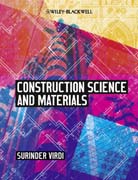
For BTEC construction students, Science, Structural Mechanics and Materials are combined into one unit. This new book focuses mainly on science and structural mechanics but also provides basic information on construction materials. The material is presented in a tried-and-tested, student-friendly format that will create an interest in science and ensure that students get all the information they need - from one book.Construction Science & Materials is dividedinto 17 chapters, each with written explanations supplemented by solved examples and relevant diagrams to substantiate the text. Chapters end with numerical questions covering a range of problems and their answers are given at the end of the book and on the book's website.The author takes into account the latest Edexcel specifications (August 2010) and provides information on topics included in Levels 2/3/4 Science, and Science and Materials. Brief coverage of building materials but more detail on science and structural mechanics topics will be included. Recent developments in science and building materials are covered as well as changes in the Building Regulations.The book includes assignments that can be used by teachers for setting coursework or by students to reinforce their learning. The assignment tasks will cover the latest relevant learning outcomes/grading criteria set by Edexcel.Students will find here all the information, explanations and self-test exercises they need to complete the mandatory topics on BTEC Construction Science and Mathematics (Level 2) as well as Construction Science and Materials (Levels 3/4).The book will be invaluable both to students and teachers as it:includes many diagrams, examples and detailed solutions to help students learn the basic conceptsintegrates science withconstruction technology and civil engineeringhas an early chapter on basic construction technology to help understand technical terminology before going through the main topicsoffers a detailed explanation of relevant topics in structural mechanicsgives end-of-chapter exercises and practice assignments to check and reinforce students’ learning; assignments provide coverage of the grading criteria set by Edexcel.The book has a companion website with freely downloadable support material:detailed solutions to the exercises and assignment tasksdetails on the design of building foundations and design of timber joistsPowerPoint slides for lecturers on each chapter INDICE: PrefaceAcknowledgementsUnits, prefixes and symbols1 Using a scientific calculatorIntroductionKeys of a scientific calculator2 Units and their conversionIntroductionLengthMassArea, volume and capacityTemperature3 Introductory physicsSpeed and velocityAccelerationMassGravitationWeightVolumeDensitySpecific gravityNewton's first law of motionNewton's second law of motionNewton's thid law of motionFrictionWorkEnergyPotential energyKinetic energyPower4 Introduction to chemistryIntroductionElectrovalency and covalencyCovalent bondElements and compoundsSymbols and formulaeAcids and basesAcidsBases5 Effects of chemicals and atmosphere on materialsIntroductionOxidationElectrolysisElectrolytic corrosionProtection of steel from corrosionApplication of electrolysisExtraction of aluminiumAcid rain6 ElectricityIntroductionCoulomb's lawElectric currentPotential differenceElectromotive forceOhm's lawElectrical resistivity and conductivityResistors in series/parallelResistors in seriesResistors in parallelTransformersPower generation and distributionPower distributionSupply to small buildings7 Introduction to construction technologyIntroductionSubstructure and supertructureSoil investigationFoundationsSettlementForms of constructionThe external envelopeGround floorsCavity wallsSuspended timber upper floorsRoofs8 Thermal energyIntroductionTemperatureTemperature scalesUnits of heatThe states of matterExpansion and contraction of solidsLinear expansionPractical examples of expansion and contractionHeat transferConductionConvectionPractical examples of convectionRadiation9 Thermal energy and humidityIntroductionThermal insulationHeat transmission Thermal conductivityThermal resistivityThermal resistanceThermal transmittanceHeat loss from buildingsTemperature drop through materialsHumidityMeasurement of relative humidityCondensationThe psychrometric chartPrevention of surface condensationInterstitial condensationPrevention of interstitial condansation10 Forces and structures 1IntroductionForceInternal and external forcesBendingDeflectionTypes of loadingDead loadImposed loadWind loadingPoint loadUniformly distributed loadTriangular loadStress and strainStressStrainElasticityFactor of safety11 Forces and structures 2Moment of a forceSign conventionLaws of equilibriumAnalysis of beamsBeam reactionsShear forceBending momentTriangle of forcesBow's notationFrames and roof trusses12 Fluid mechanicsIntroductionPressure of fluids at restCentre of pressureThe flow of a liquidBernoulli's equationThe venturimeterFlow in open channels13 SoundIntroductionFrequency, wavelength and velocity of soundFrequencyWavelengthVelocityMeasurement of soundThreshold values of soundThe decibel scaleAddition of sound levelsTransmission of sound in buildingsNoiseRequirements of sound insulationSoundinsulation techniquesNoise in a work placeMeasurement of sound insulationSound absorptionReverberationReverberation timeTypes of sound absorbersSound levelmeter14 LightIntroductionAdditive and subtractive coloursUnits for measuring lightAngular measureSolid angleLuminous intensityLuminous fluxIlluminanceLuminanceInverse square law of illuminanceLambert's cosine law of illuminanceLamps and luminairesDesign of interior lightingLight output ratioDirect ratioRoom indexReflection of lightLevel of illuminanceUtilisation factorMaintenance factorLumen design methodSHRLight meterDaylightingUniform skyCIE standard overcast skyDaylight factorComponents of daylight factorAverage daylight factor15 Human comfortIntroductionTemperatureAir temperatureMean radiant temperatureEnvironmental temperatureDry resultant temperatureActivityClothingAir movementHumidityVentilationNoiseLight16 Construction materialsBricksClassificationManufacturePropertiesDeterioration of brickworkAerated concrete blocksManufacturePropertiesCementManufactureConstituents of portland cementTypes of cementEnvironmental implicationsConcreteManufactureConcrete mixProperties of fresh concreteProperties of hardened concreteDurability of concreteEnvironmental implicationsMetalsManufacture of ironIron and its alloysProperties of steelCorrosion of iron/steelEnvironmental implicationsManufacture of aluminiumProperties of aluminiumTimberSeasoning of timberPropertiesDeteriorationEnvironmental implicationsPlasticsRaw materials and manufactureClassificationPolyethylenePolyvinyl chloridePTFEMelamine formaldehyde17 AssignmentsAppendix 1: Formulae for Example 9.2Appendix2: Solutions for Example 13.10Appendix 3: Answers to ExercisesIndex
- ISBN: 978-0-470-65888-8
- Editorial: John Wiley & Sons
- Encuadernacion: Rústica
- Páginas: 352
- Fecha Publicación: 30/03/2012
- Nº Volúmenes: 1
- Idioma: Inglés
